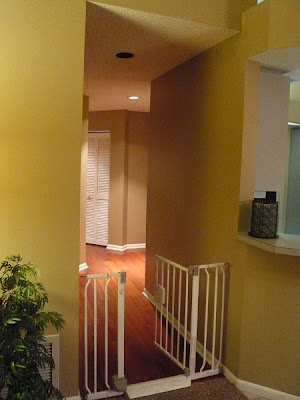Like a lot of homes built in the early '80s, this one was full of unnecessary, non-structural walls and dropped ceilings. I met the clients in question in late January and luckily, I took a couple of photographs of their home as it was the first time I saw it. Here's one:
In this photo, I am standing at the entrance to the kitchen from the breakfast nook and I'm looking toward the dining room and the front of the house. Remember that perspective. Running along the left side of that photo is a nonsensical hallway and here's the entrance to it:
That hallway was restricting the space I had available for the kitchen, but inside of its dropped ceiling was a whole host of AC equipment. Losing the ceiling and the hallway was going to make this a pretty extensive renovation. Here's the floorplan as I found it:
The kitchen was shoved into that space on the left side of the compound angle wall. Compound angle walls are a particular pet peeve of mine and I couldn't wait to get in there and bring some efficiency and some decent sight lines to this family's life.
Once I started drawing, I removed the angles and drew in a very large island.
The island needed to do a couple of things. It had to hold the sink and the dishwasher of course, but I also had to be able to hide a big espresso and coffee machine. The appliance in question is 17 inches tall, and I knew a normal raised bar wasn't going to cut it.
I called in my favorite contractor Tim Brandt from TNC Builders and we started hashing out a plan to remove everything I wanted to remove.
At around the same time that I was playing around with layouts, my pals at Google SketchUp asked me if I had a model they could use at their trade show booth at KBIS in Atlanta and the AIA show in San Francisco.
So I sent them one of my early concept drawings.
This was pretty early into the process and my clients hadn't even seen it yet. It was helpful to get an idea out there though. By the time I had everything worked out, my idea had changed a little but the concept was pretty set.
Here's what I showed my clients and what they signed off on. The raised section on the left side finished off at 54 tall as measured from the floor to the top of the counter.
I specified a wide-style Shaker cabinet door in cherry with a dark brown, nearly black stain on it.
This is pretty close to the stain color.
The floors were going to get a travertine-looking porcelain. I picked a 19" tile and I wanted it to be set on the diagonal through the whole back of the house.
The final tile was one very similar to this one from Mohawk.
I still like blue and brown color combinations, despite the conventional wisdom about them. So when it came to lighting, I looked to my old standbys, Besa Lighting.
This is Besa's Sasha II line-voltage halogen and the shade is in their Granite glass. I also used a flexible monorail from W.A.C.
The enormous island was showing a lot of back and I thought it would be a great canvas to cover in a glass tile.
This is Montana from Emenee and I ended up wrapping every exposed inch of the island and the back wall in it.
The counter is a sand-colored quartz composite from Cambria.
The kitchen faucet is the Clairette by Kohler and the sink is the Poise, also by Kohler.
The hardware is a steel bar pull from Schaub and Company, the bar stools are the Radius from Room and Board and the appliances are from KitchenAid. Hmmm, I think I have everything covered now.
So without further ado, here's how the room ended up.
And If you remember the first photo at the beginning of the post, I took it while I was standing at the dinette. Well, here's that same perspective now.
Let's see that before again:
Back in July, I wrote a post about a floor transition I'd designed and was very happy about. Here's the photo of my S curve transition.
Well, that transition was done for this project. It's kind of hard to see but the flexible track on the range and refrigerator side of the kitchen has the same S curve as the transition between the kitchen and the dining room has. Pretty slick if I may say so myself.
So bottom line, my clients spent somewhere around $60,000 for this entire project. That included a significant amount of construction as well as removing the popcorn ceilings from everywhere in the house. We were within the range of our original budget before the add-ons got added on. We started the tear out in May of '09 and walked out for the last time the first week in July. That's a nine week completion and we brought it in on budget.
And that is about as full a description of what I do as I can muster. You may now leave glowing comments. Hah!























.jpg)












